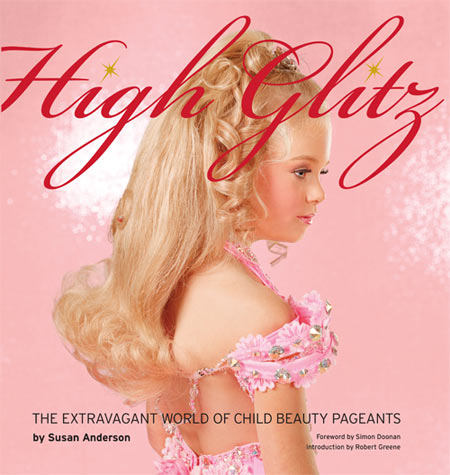Review: High Glitz by Susan Anderson

Just like almost every aspect of our modern life, child beauty pageants have become an industry that generates a lot of money for those behind them. In a nutshell, here is how this works: “There is a minimum cost of $545 to enter the [Universal Royalty] pageant, which covers basic entry fees. Another $395 is needed for the maximum options of this pageant. The average cost of the pageant is about $655 which includes the formal wear, sports wear and dance. The average cost does not include travel, hotel and food, which can be up to an extra two hundred dollars. According to several stage mothers participating in Universal Royalty, dresses for sports and formal wear can cost up to $12,000 with a minimum of $1500.” (source) The title to win is the “grand supreme”: “The grand supreme winner receives one thousand dollars in cash, ten-inch crystal crown, six-foot trophy, supreme entry paid in full to nationals, tote bag, satin rhinestone banner, teddy bear, bouquet of long stem red roses, gifts, video of the pageant, and photo on advertisement of beauty pageant.” (same source) So in a nutshell, the winner gets her/his [parents’] money back, some trophies, plus a title (which might or might not mean something). The rest also get trophies and titles, but no money.
Needless to say, these numbers just describe the economy behind child beauty pageants. But what price can possibly be put on a childhood itself? Common sense would have it that training young children (predominantly girls) to be beauty pageant contestants cannot possibly be healthy for them.
Needless to say, just as there are lots of people who, for example, believe that global warming is not caused by humanity’s emission of greenhouse gases, many people are convinced that subjecting children to beauty pageants is beneficial for them (here is an example).
Susan Anderson’s High Glitz: The Extravagant World of Child Pageants (which has its own micro-site) puts a human face to this issue by portraying contestants from child beauty pageants. Anderson is a commercial photographer, and for the book she applied her craft to these young children, all of them in full costume. It’s hard to tell how much post-processing went into the production of the images, but it is quite obvious that the children don’t look the way they are shown because of the photographer’s Photoshop skills. In other words, the photographer did not Photoshop them into the state they are in (which, if you have never seen such images, at first might be hard to believe). Most of them are very heavily made up, with spray tans, “flippers” (fake front teeth that are great for extremely fake smiles), elaborate and completely age-inappropriate dresses, plus poses that normal children do not tend to strike. The book also features an illustrated glossary of what you see in the images, all of it presented and packaged very well (something that is not always the case for Powerhouse books).
So there it is, the world of child beauty pageants. Despite having seen many episodes of the TV show “Toddlers and Tiaras”, I found the book hard to stomach. I simply could not bring myself to look through it in one go. It’s just too nauseating to see images of very young children dressed up and made up in ways that are… just wrong in any possible way. Of course, the big question is what these pageants say about our own culture, about how we see childhood, about making money… Hopefully, High Glitz: The Extravagant World of Child Pageants will trigger a bit of a debate about this.